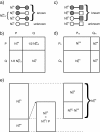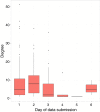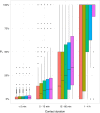How should social mixing be measured: comparing web-based survey and sensor-based methods
- PMID: 24612900
- PMCID: PMC3984737
- DOI: 10.1186/1471-2334-14-136
How should social mixing be measured: comparing web-based survey and sensor-based methods
Abstract
Background: Contact surveys and diaries have conventionally been used to measure contact networks in different settings for elucidating infectious disease transmission dynamics of respiratory infections. More recently, technological advances have permitted the use of wireless sensor devices, which can be worn by individuals interacting in a particular social context to record high resolution mixing patterns. To date, a direct comparison of these two different methods for collecting contact data has not been performed.
Methods: We studied the contact network at a United States high school in the spring of 2012. All school members (i.e., students, teachers, and other staff) were invited to wear wireless sensor devices for a single school day, and asked to remember and report the name and duration of all of their close proximity conversational contacts for that day in an online contact survey. We compared the two methods in terms of the resulting network densities, nodal degrees, and degree distributions. We also assessed the correspondence between the methods at the dyadic and individual levels.
Results: We found limited congruence in recorded contact data between the online contact survey and wireless sensors. In particular, there was only negligible correlation between the two methods for nodal degree, and the degree distribution differed substantially between both methods. We found that survey underreporting was a significant source of the difference between the two methods, and that this difference could be improved by excluding individuals who reported only a few contact partners. Additionally, survey reporting was more accurate for contacts of longer duration, and very inaccurate for contacts of shorter duration. Finally, female participants tended to report more accurately than male participants.
Conclusions: Online contact surveys and wireless sensor devices collected incongruent network data from an identical setting. This finding suggests that these two methods cannot be used interchangeably for informing models of infectious disease dynamics.
Figures




Similar articles
-
Contact diaries versus wearable proximity sensors in measuring contact patterns at a conference: method comparison and participants' attitudes.BMC Infect Dis. 2016 Jul 22;16:341. doi: 10.1186/s12879-016-1676-y. BMC Infect Dis. 2016. PMID: 27449511 Free PMC article.
-
Estimates of Social Contact in a Middle School Based on Self-Report and Wireless Sensor Data.PLoS One. 2016 Apr 21;11(4):e0153690. doi: 10.1371/journal.pone.0153690. eCollection 2016. PLoS One. 2016. PMID: 27100090 Free PMC article.
-
Contact Patterns in a High School: A Comparison between Data Collected Using Wearable Sensors, Contact Diaries and Friendship Surveys.PLoS One. 2015 Sep 1;10(9):e0136497. doi: 10.1371/journal.pone.0136497. eCollection 2015. PLoS One. 2015. PMID: 26325289 Free PMC article.
-
Close encounters of the infectious kind: methods to measure social mixing behaviour.Epidemiol Infect. 2012 Dec;140(12):2117-30. doi: 10.1017/S0950268812000842. Epub 2012 Jun 12. Epidemiol Infect. 2012. PMID: 22687447 Free PMC article. Review.
-
A comparative study of wireless sensor networks and their routing protocols.Sensors (Basel). 2010;10(12):10506-23. doi: 10.3390/s101210506. Epub 2010 Nov 24. Sensors (Basel). 2010. PMID: 22163483 Free PMC article. Review.
Cited by
-
Combining social network and activity space data for health research: tools and methods.Health Place. 2020 Nov;66:102454. doi: 10.1016/j.healthplace.2020.102454. Epub 2020 Oct 5. Health Place. 2020. PMID: 33032243 Free PMC article.
-
A Systematic Review of Social Contact Surveys to Inform Transmission Models of Close-contact Infections.Epidemiology. 2019 Sep;30(5):723-736. doi: 10.1097/EDE.0000000000001047. Epidemiology. 2019. PMID: 31274572 Free PMC article.
-
Contact diaries versus wearable proximity sensors in measuring contact patterns at a conference: method comparison and participants' attitudes.BMC Infect Dis. 2016 Jul 22;16:341. doi: 10.1186/s12879-016-1676-y. BMC Infect Dis. 2016. PMID: 27449511 Free PMC article.
-
Social encounter profiles of greater Melbourne residents, by location--a telephone survey.BMC Infect Dis. 2015 Nov 2;15:494. doi: 10.1186/s12879-015-1237-9. BMC Infect Dis. 2015. PMID: 26525046 Free PMC article.
-
Combining serological and contact data to derive target immunity levels for achieving and maintaining measles elimination.BMC Med. 2019 Sep 25;17(1):180. doi: 10.1186/s12916-019-1413-7. BMC Med. 2019. PMID: 31551070 Free PMC article.
References
Publication types
MeSH terms
Grants and funding
LinkOut - more resources
Full Text Sources
Other Literature Sources

